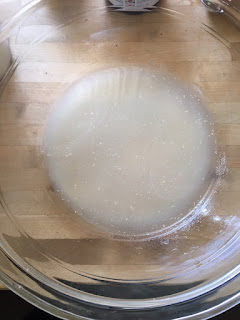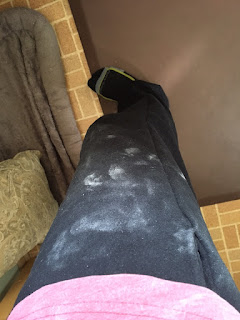Now, as we all remember from the beginning of the month, my first beignet recipe - which did not use yeast - met a little resistance from a few people who felt that beignets should always contain yeast. So... after some looking around, I came across a recipe from Paula Deen on the Food Network website. (Say what you will about Paula and the reasons she got rushed off of Food Network, her recipes have never let me down.) The recipe is for French Quarter Beignets, and I'll just let you bop over to that site for the recipe, if you want it.
On to the photos:
 |
| In the front right, you can see our brand new jar of yeast - replacing the one from the freezer, which had had a 2010 expiration date. |
I got my lukewarm water, and added the sugar, and then added the yeast.
And, when nothing happened, I stirred. And waited some more.
Then I dumped out the first batch, and got out a thermometer before starting the second batch.
 |
| I actually had to go online to find out what the right temp for yeast is - apparently whoever put all the info on the jar just kind of assumes that if you're buying it you already know what to do. |
I tried again.
This time, thankfully, stuff started to happen.
And, within just a little while, all of those little plant/animals had gorged on the sugar and bloomed all over the place in my bowl.
 |
| I learned all about yeast from Alton Brown on "Good Eats" - but aside from the fact that large puppets eat sugar molecules and burp out gases, I'm still a little unclear on it. |
 |
| I never really notice how precarious my bowls are when I'm mixing. But this one, in this photo, does make me a little nervous. |
 |
| I won't lie - it felt a little odd just dropping hunks of Crisco into the bowl and whisking. |
I switched to a spatula to scrape it all out, then...
...kneaded it around the board for a bit until it was "smooth."
If I were at home at my parents' house, I'd have set the covered bowl on a radiator to rise. But we live in a 1950s-era rambler, with wall vents. And you can't exactly set a bowl on a wall vent. So, when you're looking for the warmest place in the house, you set the bowl on top of the fridge.
Where, in about 2 hours, you find that the dough has not quite doubled in size. (I'll admit, here, that I thought my fast-acting yeast would have sped this process along. It makes me wonder how long it would have taken to get to this size with "regular" yeast.)
As I've tried to do with most of the other doughs, I opted to very closely follow the rolling out and shaping instructions.
The thickness made perfect sense.
The size of the actual "squares," however, seemed a bit small (at least at this point, I was thinking it might have been a typo).
Granted, they puffed up nicely when I fried them, but... still... pretty darned small.
So, having made one batch as instructed, I cut up the rest of the dough in a much more expected (at least by me) two-inch-ish size.
Which fried up ever-so-puffily.
 |
| Along the way, I somehow ended up making a Beignet Minnesota! |
In the picture, below, the one cooked at the higher temp is on the left, the one at the lower temp is on the right. Christopher and I both felt that the lower temp beignet had the better texture - possibly because it was given a little longer to rise in the pan before the outside got too hard.
You probably also noticed that there are some "square donut" looking ones on that plate. That's because, while the small beignets were just ridiculously small, they did have a good "crunch to dough" ratio, which we lost a bit of when we made them all bigger. With the hole in the middle, we got more of that crunch in each bite.
Honestly, we were kind of thinking that if we did them again we might opt for "beignet sticks" - kind of like churros, but a bit fluffier on the interior.
Overall, I think we decided that these yeast beignets were a better texture than the other batch - though with the added two-hour resting time, it's hard to say whether that slight edge is worth it.
A few other things to wrap up our month of fried dough...
Flour can make a mess.
For instance: I'm not, typically, an apron wearer, and I sometimes wipe my hands on my pants when I'm working with dry ingredients. Thus, we have this lovely photo:
At the same time, flour can also make a mess of your oil. Prior to making these beignets, I had strained out the oil and filtered off about 3/4 cup (maybe more) of oil that had settled to the bottom of the pan after the Fry Bread. Yet, after this round of beignets (which had all been rolled out on flour), the oil was looking pretty sad, again:
By the way... I know that this has been a month of frying, and it probably seems like we've been using a ton of oil - which can't be all that healthy for us. So I wanted to show you the next picture.
This is the bottle of oil after I emptied the pan after our final beignets. You can see that the oil level is above the label.
I realize it looks like there's a lot of oil missing from the bottle, but you have to remember that at least 6 ounces of oil went in the compost bin a while back. So, over the course of five major fryings (the four breads, as well as the non-blogged-about wontons we made in January that started me on this path), we had really only lost about a cup of oil.
And we made a LOT of food. This batch of beignets, alone, produced something like two dozen of the large ones. (For the record, they lost their crunch and got a little tough after the first day.)
If you're using a fairly healthy oil (which is all relative, I realize) - and if your temp is right, so that your food is frying, instead of absorbing it all - this isn't so bad.
With that ever-so-slight nod to healthy eating, tune in next week for something fried, which - technically - has no dough involved. (The things I do for you!)
-----
I've got a couple more posts coming up based on suggestions from some of you - and they're pretty fun. Thanks for the ideas!
And, please, let me know if you have something you've always wanted to try, or you want someone else to taste, first - or you think might be a Pinterest fail waiting to happen (one of the next ones... well... let's just say it tasted good, at least) - and I'll see what I can do.



















No comments:
Post a Comment